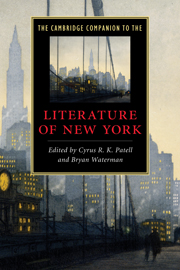Book contents
- Frontmatter
- Introduction
- 1 From British outpost to American metropolis
- 2 Dutch New York from Irving to Wharton
- 3 The city on stage
- 4 Melville, at sea in the city
- 5 Whitman’s urbanism
- 6 The early literature of New York’s moneyed class
- 7 Writing Brooklyn
- 8 New York and the novel of manners
- 9 Immigrants, politics, and the popular cultures of tolerance
- 10 Performing Greenwich Village bohemianism
- 11 African American literary movements
- 12 New York’s cultures of print
- 13 From poetry to punk in the East Village
- 14 Staging lesbian and gay New York
- 15 Emergent ethnic literatures
- Further reading
- Index
- Series list
9 - Immigrants, politics, and the popular cultures of tolerance
Published online by Cambridge University Press: 28 November 2010
- Frontmatter
- Introduction
- 1 From British outpost to American metropolis
- 2 Dutch New York from Irving to Wharton
- 3 The city on stage
- 4 Melville, at sea in the city
- 5 Whitman’s urbanism
- 6 The early literature of New York’s moneyed class
- 7 Writing Brooklyn
- 8 New York and the novel of manners
- 9 Immigrants, politics, and the popular cultures of tolerance
- 10 Performing Greenwich Village bohemianism
- 11 African American literary movements
- 12 New York’s cultures of print
- 13 From poetry to punk in the East Village
- 14 Staging lesbian and gay New York
- 15 Emergent ethnic literatures
- Further reading
- Index
- Series list
Summary
When a Jewish boy marries a Catholic girl we can expect laughs aplenty, and maybe some tears along the way: and so it proved in Abie's Irish Rose, a wildly successful play by Anne Nichols, which had a triumphant five-year run on Broadway from 1922. By 1927 there had been over 2,000 performances on Broadway and more than 11,000 performances world-wide, including a notable five-year run in the West End of London. At no time was it regarded as anything other than popular schlock. Nichols's characters speak with stage Irish and Yiddish accents richly larded with New Yorkese: vell (well), goil (girl), dose (those), pizziness (business), tink (think), nize (nice), mudder (mother), strit (street), hoits (hurts), spik (speak), pliz (please), vant (want), don'd (don't), peefle (piffle). Solomon Levy, Abie's father, summons a “texes keb” (taxi cab), and so on. The dilemmas of ethnic difference are settled with comic deftness when Rose cooks kosher food for her Abie, and makes a ham for her friends.
Abie's Irish Rose is a commercial product of American popular culture. It is also a prism in which powerful cultural forces - ethnic relations, the impact of mass immigration, and the cross-generational complexities of assimilation - are refracted, exaggerated, and also unexpectedly clarified. Popular culture is perhaps more comfortable than “high” culture with the interplay of cultural production and the immigrant experience. (It took several generations of ethnic jokes, we might say, to make Call It Sleep possible.) I take the broad ethnic comedy of Nichols’s play to constitute a fable of tolerance. In the face of great cultural pressures for assimilation, her play offered Jewish audiences, and not just Jews, a way to manage that pressure. It opened a little window for tolerance.
- Type
- Chapter
- Information
- The Cambridge Companion to the Literature of New York , pp. 134 - 145Publisher: Cambridge University PressPrint publication year: 2010



